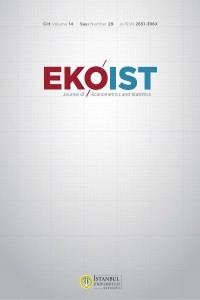STRATEJİK ÜRETİM İŞLETME PERFORMANSI İLİŞKİSİ: YAPISAL EŞİTLİK MODELLEMESİ ÜZERİNE BİR ANALİZ
Stratejik Üretim, Üretim Performansı, İşletme Performansı, Yapısal Eşitlik Modeli
___
- Ahmed, N.U., Montagno, R.V. and Firenze, R.J. 1996. Operations Strategy and Organizational Performance: an Empirical Study. International Journal of Operations & Production Management 16(5): 41-53.
- Bagozzi, R.P. 1981. Evaluating Structural Equation Models with Unobservable Variables and Measurement Error. A Comment. Journal of Marketing Research 18(3): 375– 381.
- Burgess, T.F. and Gules, H.K. 1998. Buyer-supplier relationships in firms adopting advanced manufacturing technology: An empirical analysis of the implementation of hard and soft Technologies. Journal of Engineering and Technology Management. 15: 127-152.
- Chase, R.B. and Aquilano, N.J. 1995. Production and Operations Management: Manufacturing and Services. 7. edition, London, Irwin.
- Cleveland, G., Schroeder, R.G. and Anderson, J.C. 1989. A Theory of Production Competence. Decision Sciences 20 (4): 655–668.
- Dangayach, G.S. and Deshmukh, S.G. 2006. An Exploratory Study of Manufacturing Strategy Practices of Machinery Manufacturing Companies in India. Omega: The Int. Journal of Management Science 34 (3): 254-273.
- Dangayach, G.S. and Deshmukh, S.G. 2001a. Manufacturing strategy: experiences from Indian manufacturing companies. Productıon Plannıng&Control 12(8): 775–786.
- De Toni, A. and Tonchia, S. 1998. Manufacturing flexibility: a literature review. Int. Journal of Production Research 36(6): 1587-1617.
- Fornell, C. and Larcker, D.F. 1981. Evaluating Structural Equation Models with Unobservable Variables and Measurement Error. Journal of Marketing Research 18(1): 39-50.
- Gerwin, D. 1993. Manufacturing flexibility: A strategic perspective. Management Science 39(4), 395–410.
- Hair, J.F., Anderson, R., Tahtam, R.L and Black W.C. 1998, Multivariate Data Analysis. Fifth Edition. Prentice-Hall International Inc. New Jersey.
- Hill, T.J. 1987. Teaching manufacturing strategy. International Journal of Operations &Production Management 6(3): 10-20.
- Hoyle, R. H. 1995. Structural Equation Modeling: Concepts, Issues and Applications. Sage Publication Inc. London.
- Mills, J., Platts, K. and Gregory, M. 1995. A Framework for the Design of Manufacturing Strategy Processes. Int. Journal of Operations & Production Management 15(4): 17-49.
- Schermelleh-Engel, K., Moosbrugger, H. and Müler, H. 2003. Evaluating the Fit of Structural Equation Models: Tests of Significance and Descriptive Goodness-of-Fit Measures. Methods of Psychological Research Online 8(2): 23–74.
- Schumacker, R.E. and Lomax, R.G. 2004. Beginner’s Guide to Structural Equation Modeling. Lawrence Erlbaum Associates Inc. New Jersey.
- Skinner, W. 1969. Manufacturing--Missing Link in Corporate Strategy. Harvard Business Review 47(3): 136-145.
- Smith, T.M. and Reece, J.S. 1999. The relationship of strategy, fit, productivity, and business performance in a services setting. Journal of Operations Management 17: 145–161.
- Sun, H. and Hong, C. 2002. The alignment between manufacturing and business strategies: ıts influence on business performance. Technovation 22: 699–705.
- Ward, P.T., McCreery, J. K., Rizman, L. P. and Sharma, D. 1998. Competitive Priorities in Operations Management. Decision Sciences 29(4): 1035-1046.
- Yousef M.A. 1992. Getting to Know Advanced Manufacturing Technologies. Industrial Engineering 24(2): 40–42.
- Yayın Aralığı: Yılda 2 Sayı
- Yayıncı: İstanbul Üniversitesi
A DISCRETE PARTICLE SWARM OPTIMIZATION ALGORITHM FOR BICRITERIA WAREHOUSE LOCATION PROBLEM
MUĞLA İLİNDEKİ MERMER İŞLETMELERİNE YÖNELİK VERİ ZARFLAMA ANALİZİ ÖRNEK OLAYI
AHP-TOPSIS YÖNTEMİNE DAYALI TEDARİKÇİ SEÇİMİ UYGULAMASI
YARIPARAMETRİK KISMİ DOĞRUSAL PANEL VERİ MODELLERİYLE ULUSLAR ARASI GÖÇ
TÜRKİYE'DE YENİLENEBİLİR ENERJİ ALTERNATİFLERİNİN SEÇİMİ İÇİN GRAF TEORİ VE MATRİS YAKLAŞIM
STRATEJİK ÜRETİM İŞLETME PERFORMANSI İLİŞKİSİ: YAPISAL EŞİTLİK MODELLEMESİ ÜZERİNE BİR ANALİZ
Hasan GÜLEŞ, Tahir AKGEMCİ, Mevhibe TÜRKMEN
ÇOK KRİTERLİ KARAR VERME İLE AVRUPA BİRLİĞİ VE ADAY ÜLKELERİN YAŞAM KALİTESİNİN ANALİZİ
